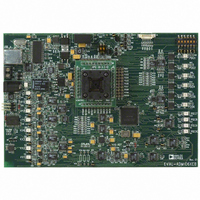EVAL-ADM1063TQEBZ Analog Devices Inc, EVAL-ADM1063TQEBZ Datasheet - Page 25

EVAL-ADM1063TQEBZ
Manufacturer Part Number
EVAL-ADM1063TQEBZ
Description
BOARD EVALUATION FOR ADM1063TQ
Manufacturer
Analog Devices Inc
Specifications of EVAL-ADM1063TQEBZ
Main Purpose
Power Management, Power Supply Supervisor/Tracker/Sequencer
Embedded
No
Utilized Ic / Part
ADM1063
Primary Attributes
10 Channel Supervisor / Sequencer, 6 Voltage Output DACs
Secondary Attributes
GUI Programmable via SMBus (via USB)
Lead Free Status / RoHS Status
Lead free / RoHS Compliant
UPDATING THE SEQUENCING ENGINE
Sequencing engine (SE) functions are not updated in the same
way as regular configuration latches. The SE has its own dedicated
512-byte nonvolatile, electrically erasable, programmable, read-
only memory (EEPROM) for storing state definitions, providing
63 individual states, each with a 64-bit word (one state is reserved).
At power-up, the first state is loaded from the SE EEPROM into
the engine itself. When the conditions of this state are met, the
next state is loaded from the EEPROM into the engine, and so
on. The loading of each new state takes approximately 10 μs.
To alter a state, the required changes must be made directly to
the EEPROM. RAM for each state does not exist. The relevant
alterations must be made to the 64-bit word, which is then
uploaded directly to the EEPROM.
INTERNAL REGISTERS
The ADM1063 contains a large number of data registers. The
principal registers are the address pointer register and the
configuration registers.
Address Pointer Register
The address pointer register contains the address that selects
one of the other internal registers. When writing to the
ADM1063, the first byte of data is always a register address that
is written to the address pointer register.
Configuration Registers
The configuration registers provide control and configuration
for various operating parameters of the ADM1063.
EEPROM
The ADM1063 has two 512-byte cells of nonvolatile EEPROM
from Register Address 0xF800 to Register Address 0xFBFF. The
EEPROM is used for permanent storage of data that is not lost
when the ADM1063 is powered down. One EEPROM cell contains
the configuration data of the device; the other contains the state
definitions for the SE. Although referred to as read-only memory,
the EEPROM can be written to, as well as read from, using the
serial bus in exactly the same way as the other registers.
(V
POWER-UP
EEPROM
CC
> 2.5V)
M
E
E
P
R
O
L
D
CONTROLLER
Figure 33. Configuration Update Flow Diagram
D
A
A
T
DEVICE
SMBus
LATCH A
Rev. B | Page 25 of 32
M
R
A
L
D
U
P
D
The major differences between the EEPROM and other
registers are as follows:
•
•
•
The first EEPROM is split into 16 (0 to 15) pages of 32 bytes each.
Page 0 to Page 6, starting at Address 0xF800, hold the configuration
data for the applications on the ADM1063 (such as the SFDs and
PDOs). These EEPROM addresses are the same as the RAM
register addresses, prefixed by F8. Page 7 is reserved. Page 8 to
Page 15 are for customer use.
Data can be downloaded from the EEPROM to the RAM in one
of the following ways:
•
•
SERIAL BUS INTERFACE
The ADM1063 is controlled via the serial system management
bus (SMBus) and is connected to this bus as a slave device,
under the control of a master device. It takes approximately
1 ms after power-up for the ADM1063 to download from its
EEPROM. Therefore, access to the ADM1063 is restricted until
the download is complete.
Identifying the ADM1063 on the SMBus
The ADM1063 has a 7-bit serial bus slave address (see Table 11).
The device is powered up with a default serial bus address.
The five MSBs of the address are set to 00111, and the two LSBs
are determined by the logical states of Pin A1 and Pin A0.
This allows the connection of four ADM1063s to one SMBus.
Table 11. Serial Bus Slave Address
A1 Pin
Low
Low
High
High
1
x = Read/Write bit. The address is shown only as the first 7 MSBs.
An EEPROM location must be blank before it can be
written to. If it contains data, the data must first be erased.
Writing to the EEPROM is slower than writing to the RAM.
Writing to the EEPROM should be restricted because it has a
limited write/cycle life of typically 10,000 write operations,
due to the usual EEPROM wear-out mechanisms.
At power-up, when Page 0 to Page 6 are downloaded.
By setting Bit 0 of the UDOWNLD register (0xD8), which
performs a user download of Page 0 to Page 6.
LATCH B
A0 Pin
Low
High
Low
High
(OV THRESHOLD
FUNCTION
ON VP1)
Hex Address
0x38
0x3Ah
0x3Ch
0x3Eh
7-Bit Address
0011100x
0011101x
0011110x
0011111x
ADM1063
1
1
1
1


















